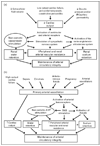Diagnosis and management of hyponatremia in acute illness
- PMID: 19005303
- PMCID: PMC2716705
- DOI: 10.1097/MCC.0b013e32830e45e3
Diagnosis and management of hyponatremia in acute illness
Abstract
Purpose of review: Hyponatremia is the most common electrolyte disorder present in hospitalized patients. Acute and severe hyponatremia can cause significant morbidity and mortality. The present review discusses the epidemiology, causes, and a practical approach to the diagnosis and management of acute and chronic hyponatremia, including the appropriate use of hypertonic saline and potential future use of the new V2 vasopressin receptor antagonists in critically ill patients.
Recent findings: The increasing knowledge of aquaporin water channels and the role of vasopressin in water homeostasis have enhanced our understanding of hyponatremic disorders. Increased vasopressin secretion due to nonosmotic stimuli leads to decreased electrolyte-free water excretion with resulting water retention and hyponatremia. Vasopressin receptor antagonists induce electrolyte-free water diuresis without natriuresis and kaliuresis. Phase three trials indicate that these agents predictably reduce urine osmolality, increase electrolyte-free water excretion, and raise serum sodium concentration. They are likely to become a mainstay of treatment of euvolemic and hypervolemic hyponatremia.
Summary: The correct diagnosis and management of hyponatremia is complex and requires a systematic approach. Vasopressin receptor antagonists are potential tools in the management of hyponatremia. Further studies are needed to determine their role in the treatment of acute, severe, life-threatening hyponatremia as well as chronic hyponatremia.
Figures


References
-
- DeVita MV, Gardenswartz MH, Konecky A, Zabetakis PM. Incidence and etiology of hyponatremia in an intensive care unit. Clin Nephrol. 1990;34:163–166. - PubMed
-
- Anderson RJ, Chung HM, Kluge R, Schrier RW. Hyponatremia: a prospective analysis of its epidemiology and the pathogenetic role of vasopressin. Ann Intern Med. 1985;102:164–168. - PubMed
-
- Upadhyay A, Jaber BL, Madias NE. Incidence and prevalence of hyponatremia. Am J Med. 2006;119(7 Suppl 1):S30–S35. - PubMed
-
- Hoorn EJ, Lindemans J, Zietse R. Development of severe hyponatraemia in hospitalized patients: treatment-related risk factors and inadequate management. Nephrol Dial Transplant. 2006;21:70–76. - PubMed
-
- Schrier RW, Berl T, Anderson RJ. Osmotic and nonosmotic control of vasopressin release. Am J Physiol. 1979;236:F321–F332. - PubMed
Publication types
MeSH terms
Substances
Grants and funding
LinkOut - more resources
Full Text Sources
Research Materials

